The battle for having the lightest gaming mouse is still raging among peripheral manufacturers, and recently the stakes have been raised by adding a wireless component to said battle. For enthusiasts it’s nice to see that companies are constantly one-upping each other with these FPS performance-oriented products, but it’s easy to forget that some gamers don’t need the latest and greatest hyper light stripped down mouse. Not everyone wants to fly around in a fighter jet; some want to travel in business class while enjoying a variety of extras during the trip.
Enter the Razer Naga Pro. This mouse was originally conceived as an MMO mouse (and that’s still its major purpose) but now has configurations aimed at FPS players, along with a range of additional features. Is this mouse worth it for FPS players or should you only go for it if you’re mainly an MMO gamer? Read our full review to find out all that and more!
At A Glance
Razer Naga Pro
The Razer Naga Pro sets out to complete one mission: it wants to be a top tier ‘all options’ gaming mouse mainly focused on MMO gamers and for me that’s definitely mission accomplished. If you’re someone who absolutely loves these larger and heavier ergonomic mice and/or you want a mouse with a great deal of customizability and extra options this is a sweet deal.
Pros
- Choice of three different side panels to fit your game of choice
- Flawless wireless performance
- Tons of buttons to customize and program
- Good build quality
- Bluetooth or USB connection, making it suitable as a work and play mouse
Cons
- On the heavier side
Specs
| Sensor | Focus+ |
|---|---|
| DPI | 100-20000, in steps of 50 |
| Polling Rate | 125 / 500 / 1000 Hz |
| Button Switches | Razer Optical |
| Connection | Wireless |
| Shape | Ergonomic |
| Length | 11.63cm |
| Height | 4.09cm |
| Weight | 117g |
| Width | 7.09cm |
First Impressions
The first thing that I noticed about this mouse was something that caught my eye before it made its way to my desk: Razer has changed their naming scheme. Whereas this mouse would be called the Naga Ultimate if we’re going by previous naming conventions it’s now called the ‘Pro.’ Razer clarified this: from this point on every top tier Razer mouse will be called Pro instead of Ultimate. I’m just putting it out there to avoid any confusion.
When I did get the mouse in my hands I noticed one other thing almost straight away: this is one chunky thing. I’m not necessarily talking about the weight here: the mouse weighs 113 with the FPS side panel attached so that’s very respectable if you look at what it offers but more about the fact that this mouse has a very substantial footprint. That’s neither a bad thing nor is it a good thing: it just is, but it’s important to note that there’s a very pronounced protrusion on the right side of the mouse that can’t be swapped out so you’ll probably want to make sure that you’re okay with that before purchasing the mouse.
Compared to the Naga Trinity the most instantly obvious change is the fact that the ‘middle of the road’ side panel now has the buttons sitting in a grid pattern as opposed to the circle that you’ll see on the Trinity. The Pro also got an upgraded sensor along with Razer’s Optical switches and a slight weight reduction.
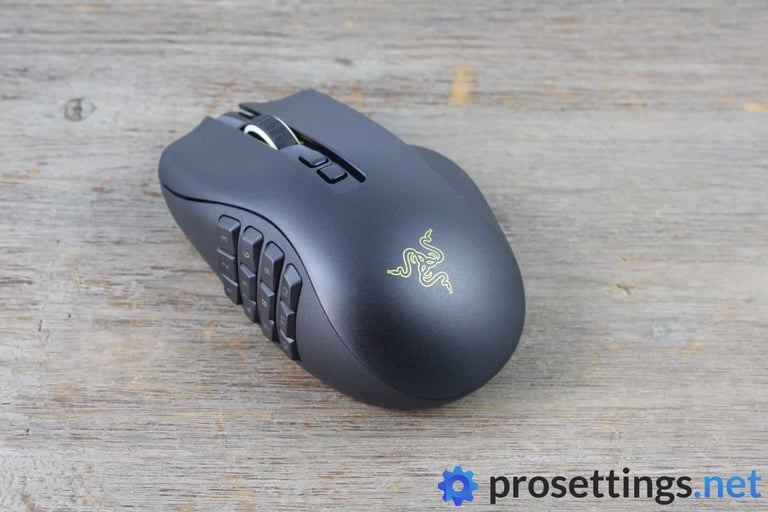
As you’ve been able to tell the Naga Pro is a large ergonomic mouse. Considering the fact that this is a wireless full option mouse the weight is surprisingly low, all things considered: the mouse itself weighs 96 grams, the FPS side panel adds 17 grams to that, the 6 button panel adds 18 grams, and the MMO side panel weighs 21 grams. This results in a maximum weight of 117 grams. That’s obviously not extremely light but in my opinion that’s rather impressive for a large and wireless ergo mouse with 12 side buttons, tilting scroll wheel and 2 DPI buttons.
Impressive here is how easy it is to change side panels: these attach via magnets, and while it’s a breeze to replace them there’s no feeling of fragility or any wobbling once they’re in place. A little more on that later though.
Packaging
Inside the box of the Razer Naga Pro you’ll encounter the mouse along with the extra side panels. There’s also a bunch of stickers, one of those ‘thank you for purchasing’ notes from the CEO, and a manual. Finishing it off we find a Razer Speedflex cable (which connects to the mouse through Micro USB) and a dongle to attach to the end of that cable so that you can place the little wireless receiver (which is found inside the mouse in a specifically designed storage spot) closer to your pad in case your PC is too far away from your playing area for your liking.
Contrary to what I got with previous top tier wireless Razer mice there’s no included USB dock here. This dock can be purchased separately or in a bundle but I’d have liked to see this included in their top tier offering, doubly so because it was there for previous releases.
Shape, Coating, and Mouse Feet
One of the defining features of the Naga shape is the fact that it has a substantial ring finger rest on the right side of the mouse. This very much forces your ring finger to sit on that ‘ledge’ and while I did not have an issue with that it is extremely important that you can live with this since the mouse becomes very difficult to hold if you’re not ‘following the guidelines’ so to say. The shape of the Naga is rather comfortable if your hand size and grip style fit it but since it does force your hand it’s not a safe shape. That’s not a problem: I wouldn’t want every mouse out there to go for a ‘one size fits all’ kind of design but it’s important to know this beforehand if you’re thinking of purchasing this mouse.
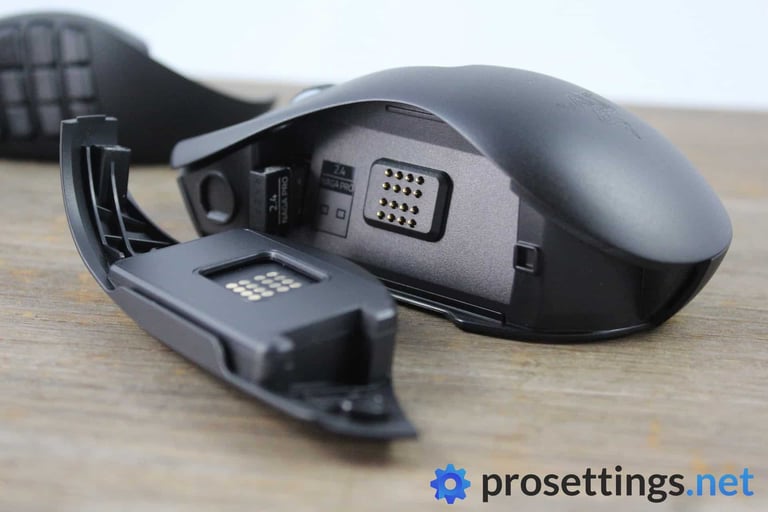
What felt a bit weird to me is the fact that it’s so short compared to how wide it is. I don’t necessarily have a problem with these super ergonomic mice but due to the shortness I often found my palm floating in the middle of nowhere while my hand kind of wanted to go for a sort of palm grip with this mouse due to the design. All of this to say: the shape isn’t for me. That’s okay because shape is so subjective, but if you’re a regular reader of my reviews this might give you an idea as to what you can expect from the design which is why I’m mentioning it. For reference: my hands are 19 x 10.5 cm and I normally use a claw grip.
As you may or may not know I’m a huge fan of Razer’s coatings and this release delivers the goods once again. Even when tested during very hot days (we’re currently having a sort of Indian summer where I live) the mouse didn’t show any dirty or sticky spots, and while the rubber element on the right side of the mouse where the pinky goes didn’t help me in particular since I use my thumb and ring finger to lift I had absolutely no performance issues here.
The two side buttons in the FPS configuration are easy to reach and easily distinguishable so no problems there. I’ll talk more about the other side panels further down in the review.
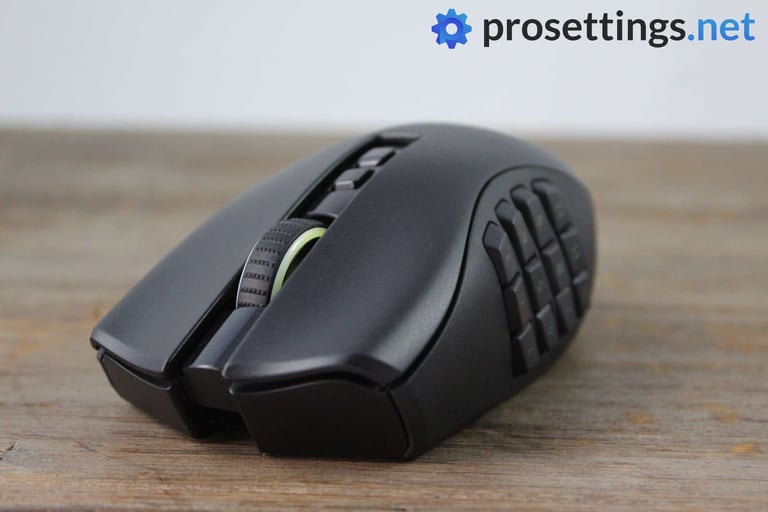
The four small PTFE feet on the bottom of the mouse are finished to a high standard and provide a smooth and pleasant glide right out of the box. This isn’t the most nimble mouse in Razer’s portfolio but that is mostly due to the weight: the skates are excellent.
Recommended Grip Types
As I mentioned earlier this isn’t the safest shape around. It’s perfect for palm or hybrid grips with a healthy dose of palm grip mixed in but I wouldn’t necessarily recommend it for claw grippers. Fingertip grippers should probably not be looking at this mouse anyway since it’s not really designed for that kind of use.
As always this is just a guideline, however. It’s entirely possible that there are fingertip grippers out there who absolutely love this mouse; no one can know what you like, and certainly not reviewers on the internet who’ve never met you so use these recommendations that you find online as guidelines, not as absolute rules.
Buttons and Scroll Wheel
When Razer debuted their Optical mouse switches a lot of people (myself included) liked the premise but felt like the execution lacked somewhat, delivering mushy clicks that, while performing as they should, didn’t feel too great. As far as I’m concerned this has now been fixed. All recent Razer mice that I’ve gotten to test have much crispier and pleasant clicks than what I experienced on the Viper Ultimate (which was one of the first mice to house these switches) so it’s pleasing to see that Razer has really been improving on this front.
The clicks themselves feel crisp and responsive, and that combined with the fact that there’s almost no sideways travel makes these clicks more than serviceable. They’re not the most amazing main buttons I’ve ever seen and there is a tiny bit of pre and post travel (though not enough to be noticeable in game situations) but these are certainly leagues above the first iterations of Razer’s Opticals and I highly doubt anyone will have a problem with these.
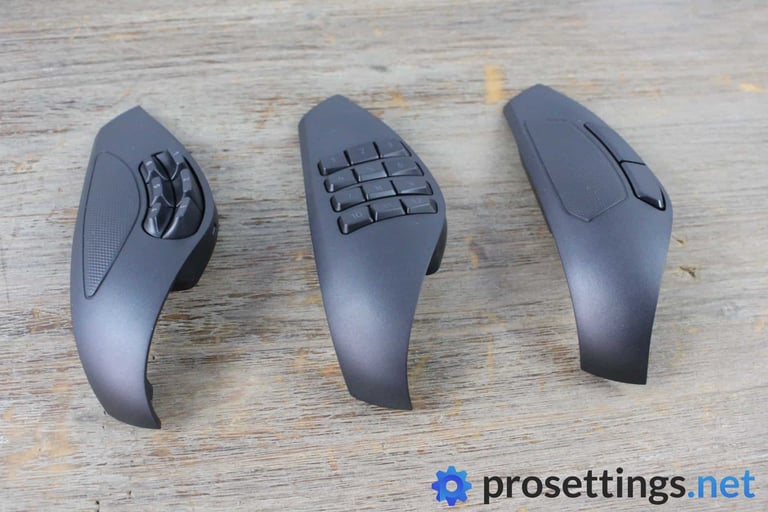
On to the side buttons then: the FPS side panel is ‘just’ the reliable two side button setup that we all know. There’s little play on the buttons and they actuate with a noticeable click so all is well on that front.
More interesting are the other two panels, of which the six button panel is my favorite. I’ll freely admit that I’m not a hardcore MMO gamer (most of my time in WoW is spent listening to the tavern song in the Goldshire inn) so perhaps I lack experience but I found the 12 button layout to be a bit confusing. The first two rows (so buttons 1 to 6) are easy enough to distinguish but after that I found myself clicking the wrong button a couple of times during intense moments. There’s also the fact that the buttons cover pretty much the entirety of the side panel so my thumb was always resting on at least one button. I never accidentally pressed any of those buttons when moving the mouse thanks to the excellent tensioning of said buttons but I did find myself enjoying the 6 button setup much more.
The six button layout has the buttons sit where you’ll normally find the two side buttons on an FPS mouse so that immediately felt more natural to me and I also found these to be easier to distinguish. I can definitely see this panel being used by players who play shooters with a bunch of abilities such as Overwatch, Valorant, or Fortnite and while I will stick to a regular FPS setup myself I can’t say that I found this setup to be annoying to use ingame: all buttons actuate with a satisfying click and are easy to find in the heat of battle. It’s a bit of a bummer that this side panel doesn’t have light up numbers like the 12 button panel does though.
The scroll wheel is excellent: it’s easy to manipulate and virtually silent, with moderately defined steps. Clicking it requires just the right amount of force if you’re asking me and they also aced it with the amount of force required to tilt it. If you’ve got an important spell or ability bound to these actions you really don’t want to find yourself accidentally aggroing a bunch of mobs so luckily everything feels rock solid here: I never once found myself accidentally doing something I didn’t intend to do with the wheel.
Build Quality and Cable
The Naga Pro actually surprised me with its overall build quality. Not that I expected it to be a noisy and rattling box of parts but I did expect some (mild) play with the side panels or what not and I’m happy to say that I was wrong. There’s absolutely no noise inside the mouse itself when shaking it around, and obviously there are no fragile construction parts to be found anywhere either: the build quality is solid as can be.
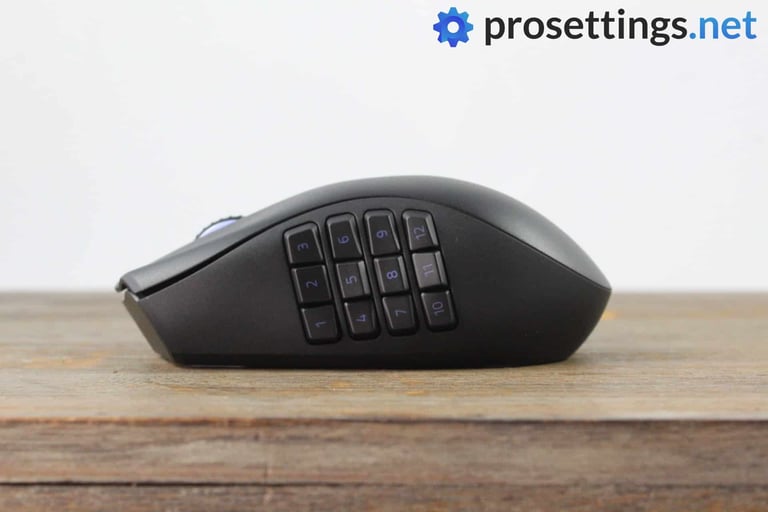
An added bonus is that the side panels really feel as if they’re part of the mouse once they’re in place. Replacing them is as easy as inserting your finger in a notch on the bottom of the mouse and pulling the panel off and then snapping a new one in place so it’s not like you have to jump through hoops to change your setup, which makes the whole experience very impressive. There’s absolutely no movement on the panel once it’s been installed to the point where it feels as if the mouse was shipped with one permanently attached side panel. Impressive.
The included charging cable is Razer’s Speedflex cable, which is a flexible and light cable that allows you to keep playing while charging the mouse without having to worry about dragging a suspension cable around, and that’s a touch that’s always appreciated on my part. You never know when you find yourself without juice and you’ve got to charge your mouse while gaming.
Sensor and Everyday Performance
Inside the Naga Pro you’ll find the Razer Focus+ Optical sensor. That’s Razer’s flagship sensor and it does the job flawlessly. The days of sensors coming with stuff like smoothing or acceleration have been over for a while now so unless a company royally screws up the implementation of a sensor you can rest assured that you’re getting reliable 1:1 performances from your hardware as long as you buy from reputable manufacturers.
Inside Razer’s Synapse software you can rebind all buttons (minus the left click button) to do pretty much whatever you want as well as change the lighting, DPI, polling rate, and LOD. It’s a bit of a downer that you need an account to use the software but aside from that I’m really liking the way Razer is handling their software these days: it’s not overly bloated (if you uncheck most optional extra installs when installing the program) and everything is laid out clearly, but if you don’t want to deal with all that you’ll be happy to know that there’s room for up to five profiles on the on board storage of the mouse.
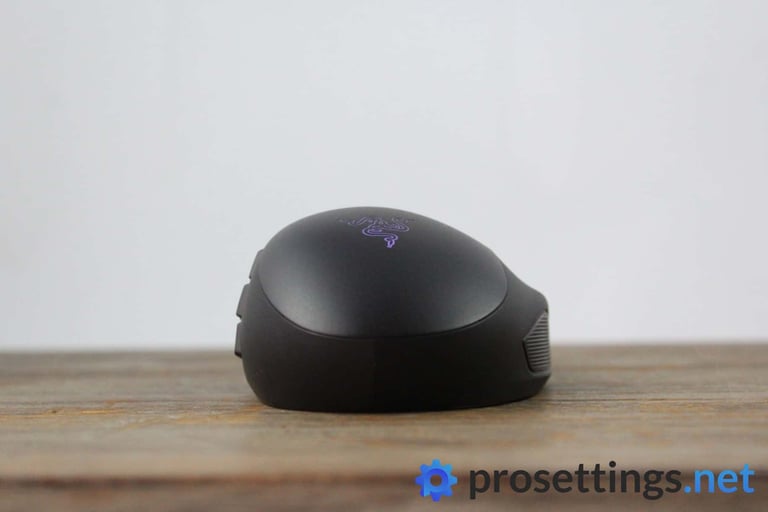
One thing I should note: Razer advertises up to 150 hours of battery life for this mouse, and that’s true for the Bluetooth mode (which is not what you want to use for gaming) but not for the HyperSpeed mode. There you get around 100 hours with all lights turned off. I didn’t fully test this but I never found myself running out of juice during testing so the battery is absolutely large enough, and should you find yourself empty you can rest easy knowing that the charging cable is flexible enough to allow you to use the mouse while charging for a game or two.
Razer Naga Pro Review – Conclusion
I don’t usually review MMO mice but since this is marketed in part as being a good option for (ability-focused) shooter games I thought I’d give it a shot. ‘Is it a good mouse for ability focused shooter games,’ you ask? Well, I’m not sure. You’d have to really love the shape or really hate using the keyboard for this mouse to be an absolute top recommendation but that doesn’t stop it from being a great mouse.
The Razer Naga Pro sets out to complete one mission: it wants to be a top tier ‘all options’ gaming mouse mainly focused on MMO gamers and for me that’s definitely mission accomplished. If you’re someone who absolutely loves these larger and heavier ergonomic mice and/or you want a mouse with a great deal of customizability and extra options this is a sweet deal. I also wouldn’t hesitate to recommend this as an MMO mouse even though I’m not exactly a pro at these kinds of games. It’s not something I’d blindly recommend if your main focus is shooter games, however. It’s a bit too heavy and unwieldy to earn top marks as a shooter mouse, and if you’re exclusively going to be using it for shooters you don’t really have any use for the other side panels so you’re better off shopping for another mouse.
Regardless of that: Razer makes plenty of mice aimed at the shooter market, and this isn’t one of them. As such I’m not judging it as that, and if you look at the task that this mouse was designed for it ticks all the right boxes. This is without a shadow of a doubt a worthy addition to Razer’s lineup of top tier wireless mice.
This product was received for free from the manufacturer and given to our reviewer to test and review. Brands and manufacturers have no editorial control over our reviews. For more information, check out our review FAQ.


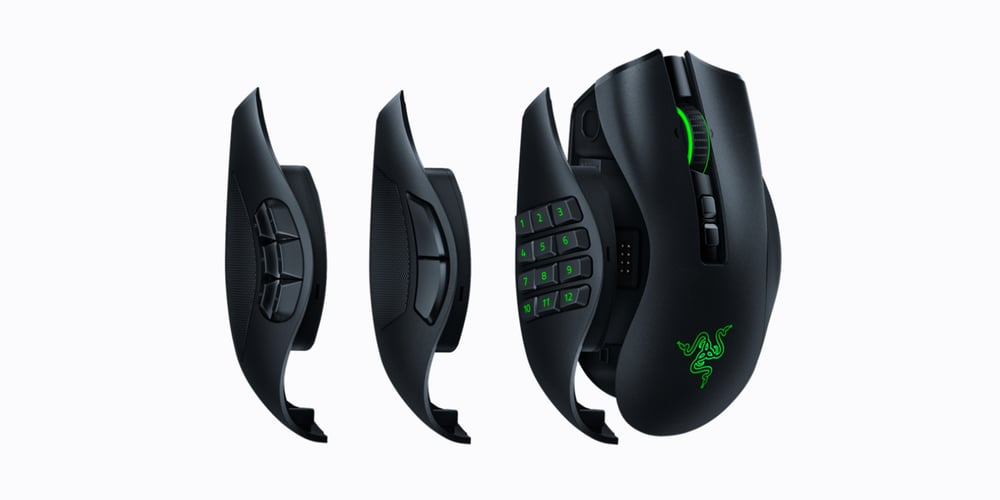

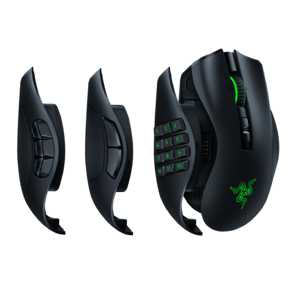


Nice writeup!
I am tempted to try this mouse.
I am a fingertip gripper with fairly large hands and I actually love mice with built up right-sides such as the one above (Used to love my trusty ol’ QPAD). Also love the fact that it has “normal” weight. I’m not a fan of those lightweight mice at all. I find the flimsiness messing with my aim. I’m a wrist aimer and I use fairly high DPI so that could be why I prefer sturdier mice that don’t pick up my “natural” tremors(?).
I tried the Naga Trinity and I loved both the fast click response and its shape, however the sensor (At least how I perceived it) felt just a bit jittery and my flickshots was never quite as consistent as with my G502 Hero. So – now I actually use the G502 as my main (even though my pinky and ring finger actually don’t particularly like its ergonomics).
Have you tried the Trinity? If so – did you notice any improvement with the Naga Pro in terms of sensor consistency?
Cheers!
– Jon
Hey Jon, thanks for the kind words! I haven’t personally tried the Trinity so I sadly cannot answer your question completely. I do know that the Trinity has a different senso than the Pro (5G vs Focus+) so they’re definitely different. I have tested a variety of mice with Razer’s Focus+ sensor and I have to say that I’m really happy with its performance, though I should say that I play at a rather low overall sensitivity so I am perhaps not the best person to gauge how it would feel for you personally.
All I can say is that the Focus+ is very highly regarded not only by myself but also by other reviewers so perhaps it’s a good idea to give it a shot. If you truly love the shape and other features I think it would be worth it to try at least and order it from a shop (if you can) with an easy return policy.
Sorry I couldn’t be of more help but I’d rather give you an honest answer (which is that I haven’t done any in depth testing of the Trinity and I don’t play at high sensitivities) than to just come up with something to seem more knowledgeable, haha.